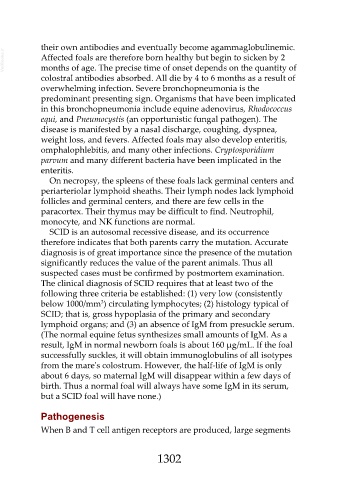Page 1302 - Veterinary Immunology, 10th Edition
P. 1302
their own antibodies and eventually become agammaglobulinemic.
VetBooks.ir Affected foals are therefore born healthy but begin to sicken by 2
months of age. The precise time of onset depends on the quantity of
colostral antibodies absorbed. All die by 4 to 6 months as a result of
overwhelming infection. Severe bronchopneumonia is the
predominant presenting sign. Organisms that have been implicated
in this bronchopneumonia include equine adenovirus, Rhodococcus
equi, and Pneumocystis (an opportunistic fungal pathogen). The
disease is manifested by a nasal discharge, coughing, dyspnea,
weight loss, and fevers. Affected foals may also develop enteritis,
omphalophlebitis, and many other infections. Cryptosporidium
parvum and many different bacteria have been implicated in the
enteritis.
On necropsy, the spleens of these foals lack germinal centers and
periarteriolar lymphoid sheaths. Their lymph nodes lack lymphoid
follicles and germinal centers, and there are few cells in the
paracortex. Their thymus may be difficult to find. Neutrophil,
monocyte, and NK functions are normal.
SCID is an autosomal recessive disease, and its occurrence
therefore indicates that both parents carry the mutation. Accurate
diagnosis is of great importance since the presence of the mutation
significantly reduces the value of the parent animals. Thus all
suspected cases must be confirmed by postmortem examination.
The clinical diagnosis of SCID requires that at least two of the
following three criteria be established: (1) very low (consistently
3
below 1000/mm ) circulating lymphocytes; (2) histology typical of
SCID; that is, gross hypoplasia of the primary and secondary
lymphoid organs; and (3) an absence of IgM from presuckle serum.
(The normal equine fetus synthesizes small amounts of IgM. As a
result, IgM in normal newborn foals is about 160 µg/mL. If the foal
successfully suckles, it will obtain immunoglobulins of all isotypes
from the mare's colostrum. However, the half-life of IgM is only
about 6 days, so maternal IgM will disappear within a few days of
birth. Thus a normal foal will always have some IgM in its serum,
but a SCID foal will have none.)
Pathogenesis
When B and T cell antigen receptors are produced, large segments
1302

